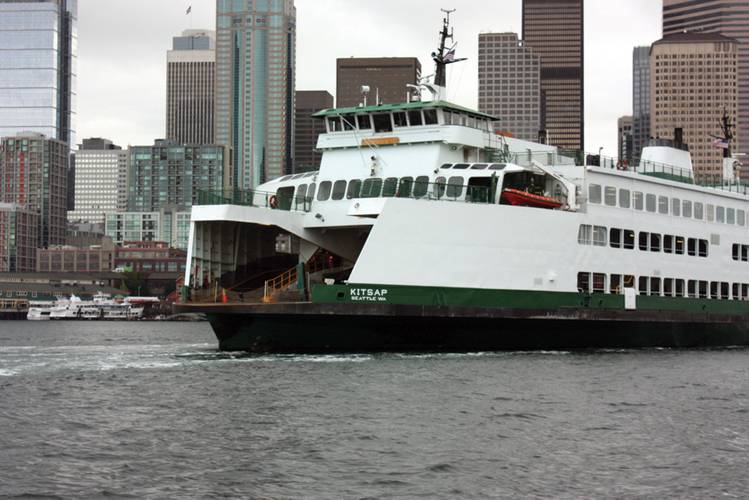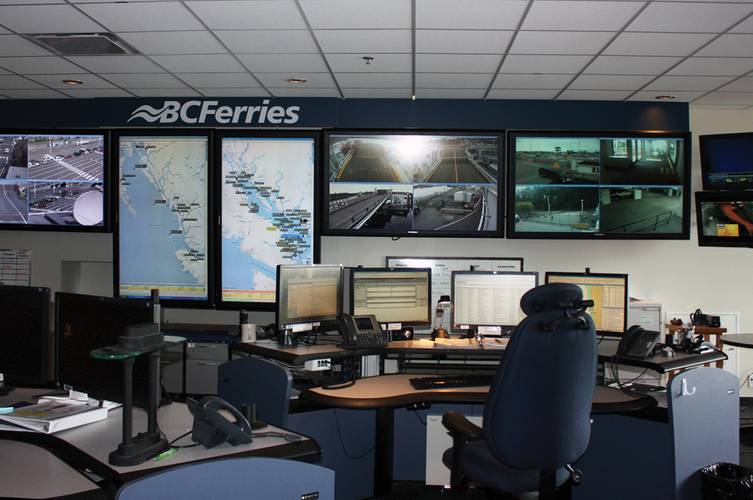BCF & WSF Security and Operations Control
Across the globe, populated islands and the desire of their inhabitants to travel elsewhere has led to a need for reliable waterborne transportation. Nowhere is an organized water transportation system more highly utilized than in the shared waters of Washington State and British Columbia. The international border zigzags around the Gulf Islands of Canada and the San Juan Islands of the US. Ferry traffic from the US and Canada traveling to these islands cross each other’s watery borders daily. All this means that the Washington State Ferry System (WSF) and the British Columbia Ferry System (BCF) must have a cooperative spirit and coordinated systems for things to run smoothly and safely.
BCF has the largest fleet of vehicle ferry vessels with 35 total ranging from their smallest 16-car ferry to the 470-car Super Ferries. WSF has 22 vessels which carry a record 11 million vehicles and 23 million passengers per year. Combined, they are the largest in the world, bar none, and all to serve an area covering only 600 air miles north to south.
Washington State Ferries (WSF) serves 20 communities in Puget Sound and the San Juan Islands from its southernmost route in Tacoma, Washington, north to Sidney, British Columbia on Vancouver Island in Canada. The BC Ferry (BCF) system covers 47 ports of call between Swartz Bay on Vancouver Island to the south and Prince Rupert to the north just short of the border with Alaska. Many of the communities served are accessible only by water or air.
The Canadian ships operate within an established navigational path, referred to as a “Guard Zone”. The path is wide in the straits and tight in the Inside Passage. Any deviation from the path sounds an alert in the BCF Operations Control Center. If the Captain hasn’t initiated contact with Dispatchers, the ship is called to ensure nothing is amiss. The Captain retains the ability to make navigational changes as needed, but the alarm system keeps Operations staff updated. Each alarm is catalogued and reviewed. A jump in incidents, near misses with other vessels, or continued re-routing can point to a trend that may require more attention or even changes to the route.
Likewise, tracking of incidents such as abandoned bags allows them to see trends that may point to purposeful testing of the security protocols, or something as innocuous as insufficient warning to passengers regarding unattended bags.
While both systems carry a significant number of tourists and vacationers, WSF has a high rate of daily commuter traffic carrying people to downtown Seattle and Tacoma for work. In their communities, the ferries are a key lifeline not just in daily life, but during a crisis as well. In a declared emergency, vessels in both WSF and BCF systems may be used to carry break-bulk cargo, deliver emergency supplies to a stricken region, or serve as mass evacuation vessels if needed. Security officials from WSF are active participants in local emergency planning and exercises.
“With roughly 250 bridges and elevated roadway structures within the City of Seattle, restoring north-south mobility will be critical to the recovery efforts in the region,” says Lawrence Eichhorn, Emergency and Security Manager for the City of Seattle Department of Transportation. “As we work to restore damaged roadways, we will rely on other transportation modes such as the Washington State Ferry system to mitigate … mobility impacts by moving responders, service providers, disaster relief resources, and employees … throughout the Puget Sound region.”
Security for the WSF is a triad of Ferry System Security staff, Washington State Patrol and the US Coast Guard. As part of the Marine Highways System, the Ferries have oversight from multiple agencies; Washington State Department of Transportation (WSDOT) as well as the US Coast Guard on operational and regulatory issues, with the WSP providing terminal security with their K9 units and uniformed officers riding the vessels on the bridge. Onboard ship, the level of security has increased significantly since 9/11. Surveillance cameras, intrusion alarms, logged entries and more are transmitted to security personnel in real-time from every ship. Details are tightly held and require Security Clearances to even work on the equipment.
BC Ferries has a new $8.5M Operations and Security Center located in downtown Victoria. In a crisis, the two full-time Ops stations can be augmented with a third position if circumstances warrant. In addition, their Emergency Operations Center (EOC) is connected to the Operations Room and would be activated in a full Incident Command System (ICS) structure in a crisis. Because Victoria and Seattle are located in earthquake zones, BCF backs up their operation with a mirrored hot-site located in a building built for a 9.5 earthquake. Staff can relocate to that building in approximately 10 minutes from their current location if necessary. WSF can re-locate to the City of Seattle’s EOC, also built to the highest earthquake standards.
Each has only two dispatch watch standers on duty during heavy operational hours, and WSF reduces that to a single dispatcher during quieter hours. Technology, Automated Information System (AIS), Vessel Tracking System (VTS) and webcam networks help keep track of vessels, emergencies, disruptions and threats - a key reason they can operate with such limited crews. At BC Ferries, vessel tracking screens powered by MS Virtual Earth and AIS, display ship locations on a large satellite map in the Ops Center. Dispatchers can toggle between 700 live video camera feeds that monitor facilities, terminal traffic, waiting lines, and more. Much of this information and some camera views are shared freely with the public. When the onboard ship cameras are integrated into the system in near future, the number of camera feeds will jump to over 1100.
Integrating all of the incoming data into a coherent picture was the brainchild of Gregg Clackson, Director of Operations and Security. “I knew what I wanted it to look like and what had to go into the picture,” says Clackson. He contracted Cameleon software integrators to fulfill the vision, though he’s quick to say it wasn’t all his ideas. He elicited support for the expanded use of automation with a promise to captains and dispatchers alike that the new program would simplify their lives and significantly reduce the paperwork involved in reporting an incident. “When they heard that,” says Clackson, “they asked how soon it could be done.” Today, the Incident Commander, usually the Captain, makes one phone call to the Ops Center to set the response process in motion. From that point on, the Incident Commander speaks only to the Ops Center. He no longer has to field dozens of endless repetitive phone calls. Ops personnel initiate the automated reporting process that includes notification alerts to pre-identified staff. Public Affairs then activates their Social Media process to notify customers of any system problems that may influence their trip planning. BC Ferries’ Twitter account boasts over 13,000 followers.
Since the simplified reporting system was introduced, reported incidents have jumped significantly. According to Clackson, this is a result of under-reporting in the old system, not an actual increase in incidents. Today, trackable results give Security personnel a realistic view of events that allows them to better prepare and plan for future events.
Despite the differences in the size and scope of their Security and Operations Centers, both agencies handle an impressive range of incidents over the course of a year. BCF reports about 6000 incidents per year, mostly stolen bags or other customer issues, but they also handle numerous larger issues; accidents with injuries, rendering assistance at sea – sometimes performing active rescues, other times acting as a windbreak while Coast Guard assists vessels in heavy seas. In 2011, BCF vessels responded to 21 marine emergencies and 58 medical emergencies. WSF attended to over 1500 medical priority loads in 2011. Hospital care and emergency medical events cannot be handled in many of the island communities and the ferries frequently answer emergency calls to transport ambulances and patients to critical care facilities on the mainland. During any emergency response, Ops Center Dispatchers manage the overall event, though individual Captains remain in control of their ships.
If the incident size makes it impossible for dispatchers to manage the incident while simultaneously keeping the general operation going, an EOC may be activated in an adjoining room. Says Christopher Kennedy, WSF Fleet/Facility Security Officer, “We want to keep response personnel close to our Dispatch stations, but removed enough to not interfere with their jobs.” In a larger scale event, command would likely shift to the WSP EOC with liaisons sent to the USCG’s Joint Harbor Operations Center (JHOC). Well-trained staff and top-notch technology combine to ensure that these two marine transportation giants continue to operate safely and securely in quiet times, yet are able to respond quickly to emergencies of all kinds.
(As published in the October 2012 edition of Maritime Reporter - www.marinelink.com)


















